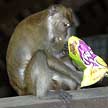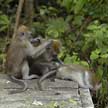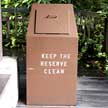 EXPLORE•EXPRESS•ACT!
EXPLORE•EXPRESS•ACT! |
|









|
Please
don't feed the monkeys
You will do them more harm than
good
People
feed monkeys to have a closer look at these fascinating creatures.
Some people think the monkeys are starving.
Monkeys are not starving
The monkeys in our wild places have lots of natural food available
to them. They have been living in our forests long before people
stayed on our island! By eating their natural fruits and food,
monkeys also help our forest to regenerate and to ensure a balance
in the forest.
Monkeys prefer the easy life
Monkeys, however, will prefer easy handouts from humans and
will stop looking for food in the forest. They wait along the
roads at the forest edges during "feeding time". They rush toward
approaching cars and often get knocked down. Since mid-2002,
15 monkeys have been reported killed on the roads near our reserve
boundaries. There may be more not reported.
Monkeys used to being fed
may become a nuisance
Monkeys will also approach humans, especially those carrying
plastic bags, which they have learnt to associate with food.
Monkeys often try to snatch plastic bags, or food held by small
children. As humans try to protect themselves or their children
by hitting out at the monkey, the monkey will in turn also retaliate.
An ugly incident may develop. Complaints about aggressive monkeys
often result. When "bad-mannered" monkeys become a serious nuisance,
it may become necessary to trap them. |
More about our monkeys
The monkeys commonly encountered in our wild places are
Long-tailed macaques (Macaca fascicularis). These
animals are native to Singapore and their original habitat
was mangroves. In fact, they are sometimes also called
Crab-eating macaques.
Monkeys are social animals just like us. In the wild,
they live in groups of 15-30 monkeys. Their social structure
and behaviour are almost as complex as ours.

Each monkey group (called a troop) is made up of a dominant
male monkey, also known as the alpha male, and his harem
of female monkeys. The troop may include a few other male
monkeys are well.
Monkeys spend a lot of time grooming each other. To them,
this is an important social activity for developing "friendships".
What
are the
monkeys' natural food?
In one study, the monkeys were observed to eat 186 different
types of plants. This is a large proportion of the estimated
300 species that were fruiting in the forest during the
study period. They also eat young leaves and shoots, and
flowers too.
Monkeys also eat animals such as small reptiles, spiders
and insects. |
|
What
happens to trapped monkeys?
Trapped monkeys are put to sleep. They are not translocated
to other parts of the Reserve as they are unlikely to be accepted
into troops already existing in the forest. All alone, without
a group, they are unlikely to survive.
Too many monkeys
Feeding also results in an unnaturally large monkey group size.
A normal group of monkeys in the wild usually has 15-30 members.
Groups that are fed by humans can be twice as big or more. More
monkeys in a group mean more conflicts between monkeys. |
EIGHTY
monkeys are culled here each year because they become
too aggressive
According to Mr Madhavan Kannan, head of the Agri-Food
and Veterinary Authority's Centre for Animal Welfare and
Control, the macaques are caught with the help of residents
who live near the nature reserves.
These monkeys are trapped when they venture out of their
natural habitat and cause a nuisance in the neighbourhood.
They would either threaten people or become a nuisance
by raiding homes and stealing food.
Explaining why they have to be culled, Mr Kannan said:
'These monkeys have come out of their troupe because they
are a misfit among them. We are unable to determine as
to their original habitat. To return these monkeys back
to the forest will pose a hazard to them as the troupe
does not accept them.'
He added that the Singapore Zoo does not accept any more
monkeys as it is constrained by the lack of space.
from the Straits Times, 24 Jun 05 |
|
How
can I save the monkeys?
Leave them alone.
Watch them from a distance and respect their natural diet and their
natural role in our forests by not feeding them.
Be a responsible visitor to our wild places
- Do not offer
food to the monkeys.
- Do not bring
food and or eat in the Reserves.
- Avoid carrying
plastic bags openly in the Reserves
- Make sure
your children are not eating or holding food near monkeys.
- Dispose your
litter into the monkey-proof bins provided. Better still, take
your litter out of the Reserves with you.
If you see people
feeding the monkeys, explain gently why this hurts the monkeys. People
who feed monkeys usually mean well and will usually eventually understand
and stop feeding them.
Join volunteers who support NParks in outreach efforts to educate
others about this issue. More details on the NParks
website. |
Links
Media article
on the consequences of feeding monkeys
- Feeding
monkeys the cause of all that aggression
Straits Times Forum 11 Dec 09;
- Monkeys
get aggressive with residents living near MacRitchie
Straits Times Forum 7 Nov 09;
- Aggressive
monkey business at MacRitchie Reservoir Park
Straits Times 23 Jan 09;
- More
monkeys caught in AVA traps
Arti Mulchand & Esther Tan, Straits Times 22 Mar 08
- Monkey
Mayhem in Bukit Timah
Arul John, The New Paper 12 Mar 08;
- NParks
clamps down on those who feed monkeys in parks
Channel NewsAsia 31 Jan 08;
- $4,000
fine for feeding monkeys
Elena Chong, Straits Times 24 Jan 08;
- Natural
to feed the monkeys? Educated adults should know better
Letter from Agnes Tan Suan Ping (Mdm), Straits Times Forum 2 Jan
08
- They're
still feeding the monkeys NParks may up fine and rope in security
firms to nab culprits
Arti Mulchand, Straits Times 31 Dec 07
- Monkey
mayhem at MacRitchie Reservoir
Monkey feeders to blame, says NParks 15 primates grabbed food
from picnicking mum and toddler Tracy Sua, Straits Times 29 Dec
07;
- Monkey
mayhem at MacRitchie Reservoir Monkey feeders to blame, says
NParks 15 primates grabbed food from picnicking mum and toddler
Tracy Sua, Straits Times 29 Dec 07;
- Monkeys
downgrading to heartland
By Teh Jen Lee The New Paper 5 Jul 07
- When
feeding monkeys = loving them to death
By Yap Su-Yin Straits Times 21 May 07
- Stressed
Singaporeans crack down on thieving monkeys
By Gillian Murdoch The Star 19 Feb 07
- Install
CCTV to stop people feeding monkeys
Letter from Dr Goh Kian Peng Straits Times Forum 1 Jan 07
- Don't
feed monkeys, it does them harm
Reply from Sharon Chan (Ms) Assistant Director, Central Nature
Reserve National Parks Board Straits Times Online 9 Oct 06
- Monkey
havoc: Man, not animals, the real culprit
Letter from Anthony Lee Mui Yu Straits Times Online 7 Oct 06
- Monkeys
in nature reserve not a threat to people
Letter from Mrs Jackie Phillips Straits Times Online 5 Oct
06
- Monkeys
in parks are becoming more aggressive
Letter from Felix Wong Soon Huat Straits Times Online 5 Oct
06
- Step
up patrols to stop people feeding the monkeys
letter from Anthony Lee Mui Yu Straits Times Online 4 Oct 06
- Monkeys
creating havoc in Windsor Park estate
letter from Dr Reuben Wong Kong Min Straits Times Online 3
Oct 06
- Undergrad
suffers brain injury after monkeys cause crash
by Nur Dianah Suhaimi Straits Times 1 Oct 06
- Take
action on motorists who feed monkeys at Upper Peirce Reservoir
Letter from Ng Yannyann (Mdm) Straits Times Forum 27 Sep 06
- Despite
all the warnings, people continue to feed the monkeys
Letter from Larry Quah Chai Koon Straits Times Forum Online
17 Feb 06
- Public
urged not to feed wild monkeys
Reply from NParks Straits Times Forum 31 Jan 06
Blog
entries about feeding monkeys
Related articles
on Singapore: exotic
species, pets and our wild places impact, issues, efforts, discussions
Efforts
for monkeys affected by feeding
- Seeking
the green light for animal sanctuaries: YES Plans for halfway
house on Pulau Ubin for confiscated wildlife get in-principle
OK by Chang Ai-Lien Science Correspondent
- NO
Expats' proposal to turn Pulau Tekukor into Monkey Island rejected
and Monkeys that turn too aggressive culled
By Jane Ng The Straits Times, 24 Jun 05
|
|
|










